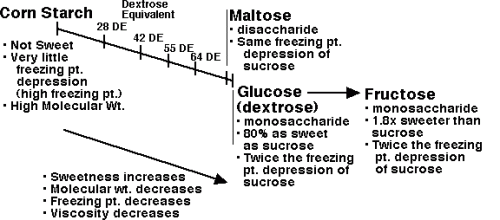Ice Cream Mix Ingredients
12 Sweeteners
A sweet ice cream is usually desired by the consumer. As a result, sweetening agents are added to ice cream mix at a rate of usually 12 – 16% by weight. Sweeteners improve the texture and palatability of the ice cream, enhance flavors, and are usually the cheapest source of total solids.
In addition, the sugars, including the lactose from the milk components, contribute to a depressed freezing point so that the ice cream has some unfrozen water associated with it at very low temperatures typical of their serving temperatures, -15° to -18° C. Without this unfrozen water, the ice cream would be too hard to scoop. See also the discussion of freeze concentration in the ice cream structure section. The effect of sweeteners on freezing characteristics of ice cream mixes is demonstrated by the plot shown on the ice cream freezing curve.
Sucrose is the main sweetener used because it imparts excellent flavour. Sucrose is a disaccharide made up of glucose (dextrose, cerelose), and fructose (levulose). Sucrose is dextrorotatory – meaning it rotates a plane of polarized light to the right, + 66.5° . With hydrolyzed sucrose the plane of polarization is to the left, “inverted” -20° . An acid, plus water, plus heat treatment, at concentrations above 10%, yields invert sugar and increases the sweetness.
It has become common in the industry to substitute all or a portion of the sucrose content with sweeteners derived from corn syrup. This sweetener is reported to contribute a firmer and more chewy body to the ice cream, is an economical source of solids, and improves the shelf life of the finished product. Corn syrup in either its liquid or dry form is available in varying dextrose equivalents (DE). The DE is a measure of the reducing sugar content of the syrup calculated as dextrose and expressed as a percentage of the total dry weight. As the DE is increased by hydrolysis of the corn starch, the sweetness of the solids is increased and the average molecular weight is decreased. This results in an increase in the freezing point depression, in such foods as ice cream, by the sweetener. The lower DE corn syrup contains more dextrins which tie up more water in the mix thus supplying greater stabilizing effect against coarse texture.

An enzymatic hydrolysis and isomerization procedure can convert glucose to fructose, a sweeter carbohydrate, in corn syrups thus producing a blend (high fructose corn syrup, HFCS) which can be used to a much greater extent in sucrose replacement. However, these HFCS blends further reduce the freezing point producing a very soft ice cream at usual conditions of storage and dipping in the home.
On the right is a diagram illustrating the effect of DE and maltose or fructose conversion on the properties of corn starch hydrolysates as used in ice cream.
A balance is involved between sweetness, total solids, and freezing point.

